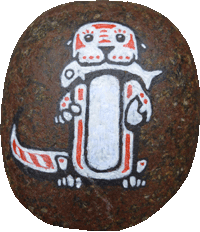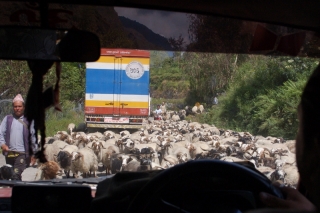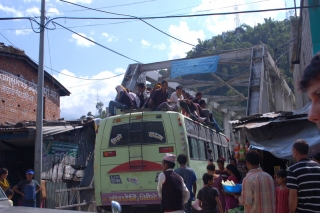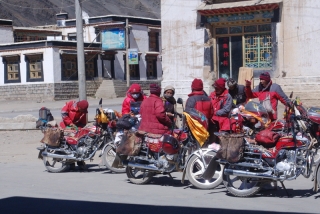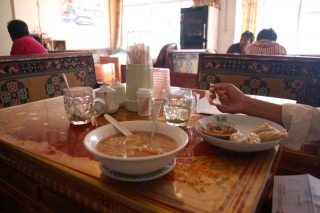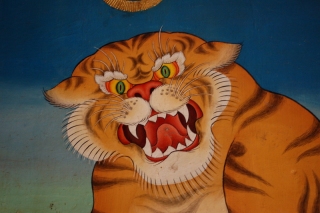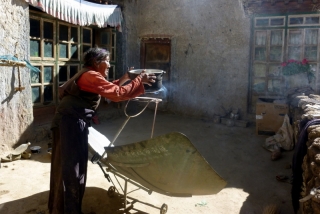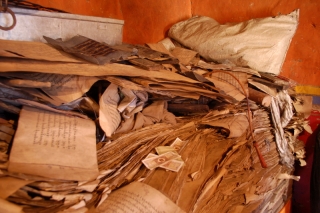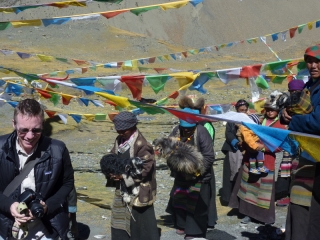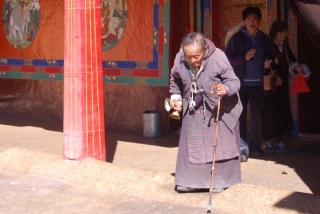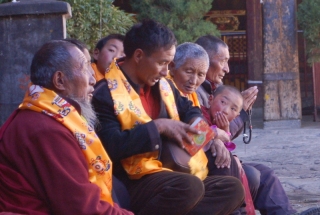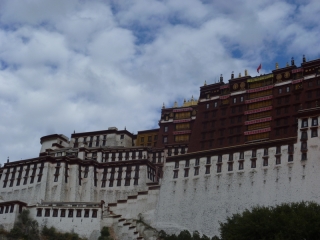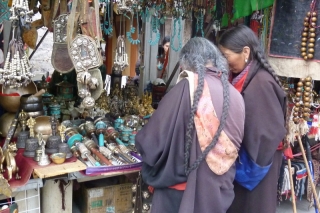Written by Maureen
Day One
An early start from Kathmandu in order to reach the Chinese border before it is closed. After an hour our driver finds he’s left some important documents, so we go back to Kathmandu to find his brother with the docs on the roadside. The road to the border is the worst we have experienced yet, a five-hour bouncy ride along a narrow track, shared intermittently with overloaded buses (one has goats riding on its roof!), large lorries with bald tyres that slither as they struggle uphill, herds of unruly sheep and crazy cyclists on their way back from Tibet.
We reach the border safely and have a long wait while our paperwork is minutely examined by unsmiling Chinese officials. After a manual bag search, an x-ray, and a close look at our books, we are finally allowed to enter Tibet. We meet our guide Tenzin and transfer onto a minivan for the drive to Zhangmu, a characterless border-town, for a late lunch. Tibetan restaurants have several colour-coded thermos flasks; locals get the Tibetan tea, we get hot water over jasmine tea.
After lunch, we drive up mist-shrouded gorges to our first stop in Nyalam (3,750m), a sleepy freezer of a town. Our hotel is new but only has two washbasins to share between all the guests and mixed-sex showers and toilets. But we are made happy by the pink padded kimonos. Dinner is a short walk away, at “Tibetan restaurant” which has a Chinese cook and a Chinese menu. Matt suffers from a bad headache all night.
Day Two
Tenzin explains that we cannot visit Shakya monastery as per our itinerary, because it is not listed on his permit. Instead, he suggests that we skip Lhatse, our intended overnight, and drive on to the city of Shigatse because “then we have a whole day there tomorrow to do things.” So after a breakfast of fried egg on pancake, we set off. We wind through mile upon mile of barren moonscape dotted with the occasional barley fields and small villages, the titanic Himalayas and other mountain chains forming a distant backdrop. Colourful villagers going about their business provide some interest during the journey.
At lunch in Shegar (yak soup), we try Tibetan tea for the first (and hopefully last) time. It is rich, salty and buttery – which is surely the very antithesis of what a drink should be. Every time we gag down half the cupful to appear willing, the darned waitress fills it back up!!! We pass several checkpoints and drive over three high mountain passes. At Gyatso-La (the highest at 5,220m), the spectacular mountain view is somewhat obscured by Tibetans in local costume cajoling tourists for money. Around here, I get a headache and start to feel nauseous, a condition which does not improve during the rest of the drive.
Eventually we arrive at Shigatse, both feeling too poorly for dinner. We dose ourselves on Neurofen, TravelEeze, Co-codemol and Rennie to no avail (the coca tea, given to us by Carmen back at Storms River, peps us up a little). Our hotel room smells of wee. Tears and homesickness.
Day Three
I stay in bed, Matt manages a little breakfast. Eventually we totter out to visit Tashilhunpo monastery, home of the Panchen Lama, and the best preserved monastery in Tibet. We zip around the complex in an hour, since it closes at midday.
After this, we wander the streets aimlessly with our guide – he is clearly wondering what to do with us. Shigatse is looking very modern these days, the old Dzong (fort) has been converted into a modern hotel, and we never did find the old Tibetan part of town. We end up in an internet bar; a dingy, smoky room with lots of PCs and young Tibetans playing computer games.
At lunch (yak with radish cooked in juniper) we listen patiently as our guide struggle to explain the history of Tibet. After a short siesta back at the hotel, we stroll to the Tibetan market, to find it already closed up for the night. We go back to the restaurant to meet up with our guide, but where is he? We order and eat (yak curry), and get the bill. Still no Tenzin. A dark walk back to the hotel, admiring the nice new streetlamps which nevertheless are unlit. My turn this night to be suffering from a splitting headache.
Day Four
We both manage breakfast this morning: dry bread, peanuts, a boiled egg and radioactive jam. Tenzin claims to have passed the restaurant three times and not seen us. Hm. Following a bit of research we ask to deviate from the itinerary and stop at little Shalu monastery, and it is like stepping into a different world. The monks are chanting scripture in the assembly hall. In the chapels, worshippers top up candles with spoonfuls of yak butter and make cash offerings to Buddha. This is a “working” monastery, and we are charmed by it.
After the visit we abandon Tenzin and go for a walk around the village of Shalu, amusing the locals with our few (three!) words of Tibetan. An old lady invites us into her home where we can take pictures of the village from the roof (for a small donation, of course). Still, this is more like the Tibet we had imagined.
Happy, we drive on to Gyantse, where we have lunch (yak chilli) at Yak restaurant; a savvy, tourist-friendly establishment that apparently has branches in Lhasa and Sigatse. In the afternoon, we visit our third monastery, the Pelkor Chode, and the delightfully named Kumbum which is a renowned four-storey stupa. Amused in one of the chapels to watch a monk toting up fat wedges of small-denomination notes, the usual offerings at Buddhist monasteries. The Kumbum is fun to explore, even if the colourful Tibetan murals get a bit samey after the first few hundred (“kumbum” means literally “10,000 images”).
After this we wheeze up the hill behind the ramparts of the monastery to get spectacular views of the valley. We return to the hotel on foot, via the old Gyantse village, past friendly locals in the process of paving their road. Dinner at Yak restaurant again (“pot-au-feu de yak”). We seem to have caught a chill, the hotel is unheated and we can’t get hot water. We sleep under three duvets tonight.
Day Five
Tenzin had emphasised last night that we need to leave early today, so we show up promptly at 8 o’clock for breakfast. But where is Tenzin? Forty five minutes later, he turns up and we finally leave Gyantse. Our first stop is the Ralung monastery, situated on a plateau in the middle of nowhere, and accessed by a crumbling dirt road. The monastery is set below snowy mountains, but is a remnant of its former glory. Like many monasteries in Tibet it was mostly destroyed during the cultural revolution and only a fraction remains. A monk shows us around, and Tenzin translates. In the chapels, centuries-old scriptures are piled up in a dishevelled heap.
We leave the monastery and drive past lone shepherds tending huge flocks of sheep. We confuse our guide by asking to stop to photograph deer and various birds. Lunch is in a tourist restaurant (buffet, no yak involved as far as we can tell).
We drive past turquoise lake Yamdrok, revered by Tibetans, and to Karo-la pass (5,045m) where we are pursued relentlessly by goat-cradling Tibetan women (“Picture! Money!”). Good view of Karo-La glacier though. The road down is twisty-turny. Our creaky van tries to overtake 20 army convoy vehicles; not an experience I want to repeat in a hurry. Near Lhasa, we dutifully take photos of a stone Buddha before escaping from the throng of tour groups asap. The rest of the drive to Lhasa is disappointingly dull, along wide streets lined with new Chinese buildings. We pass the famed Potala palace, looking out of place on its rock amidst the busy modern city. At Flora hotel (at last, a decent hotel!) we have bath, dinner (yak gratin), and collapse.
Day Six
We swap altitude sickness for the common cold and are subsequently a bit grumpy when Tenzin fails to turn up on time again, after telling us we need to have an early 8AM start. Eventually we head off to Drepung, our fifth monastery. This is the busiest monastery yet, with lots of pilgrims shuffling through the different chapels and depositing money at the statues of whichever buddhas, lamas or other dieties they prefer.
We have lunch in a restaurant on Barkhor square, where the waitress neglects to mention that the meatballs we ordered will take an hour to make (meatballs = yakballs?). Barkhor is an interesting place where perambulating pilgrims rub shoulders with tourists, monks and merchants. The square is lined with colourful stalls selling everything from electric blenders to robes for the discerning monk. We wander around happily, people-watching, and indulge Tenzin by stopping at a couple government handicraft shops so he can earn a star (twenty stars earns him an extension to his guide permit).
In the afternoon we visit the Jokhang, the most important Buddhist temple in Tibet, and spend an amiable time watching monks and tourists alike. Dinner is burnt yak burger in an empty restaurant.
Day Seven
The thousand or so steps up to the Potala palace nearly defeats me, thanks to my cold and altitude. I am suffering from a shortness of breath and arrive at the top a pathetic, wheezing wreck. Tenzin suggests that we pretend not to be with him at checkpoints, so we can by-pass the 40 minutes limit imposed on tour groups. Naughty!
The palace was once home to the Dalai Lama but is now occupied by a few monks and the Chinese army. It is opulent but devoid of atmosphere. We fight our way through shoals of Chinese tour groups, each towed along by a belligerent guide. It ends up only taking 40 minutes anyway. Glad to leave.
After lunch we go to Sera monastery, a few minutes out of the city. I am dragging my feet at the prospect of another monastery, but I didn’t count on the debating monks! Every afternoon, monks of the monastery gather in the debating courtyard and argue over philosophy in the most animated fashion. It is quite a spectacle, I won’t try to describe it – video to follow! At the monastery, we also join the queue of pilgrims and touch our foreheads to the foot of Tamdrin, the horse-headed god of meditation and protector against mental illness. Ahhh, to be sane again.
We return for a last walk around the Barkhor. Tomorrow morning, we fly to Kathmandu, assuming of course that Tenzin gets us to the airport on time. At dinner (yak tongue), we discuss the last seven days. Our conclusion? Yes, it was worth all the ailments. Tibet is still a special place and we would return here one day.
Related Images:
